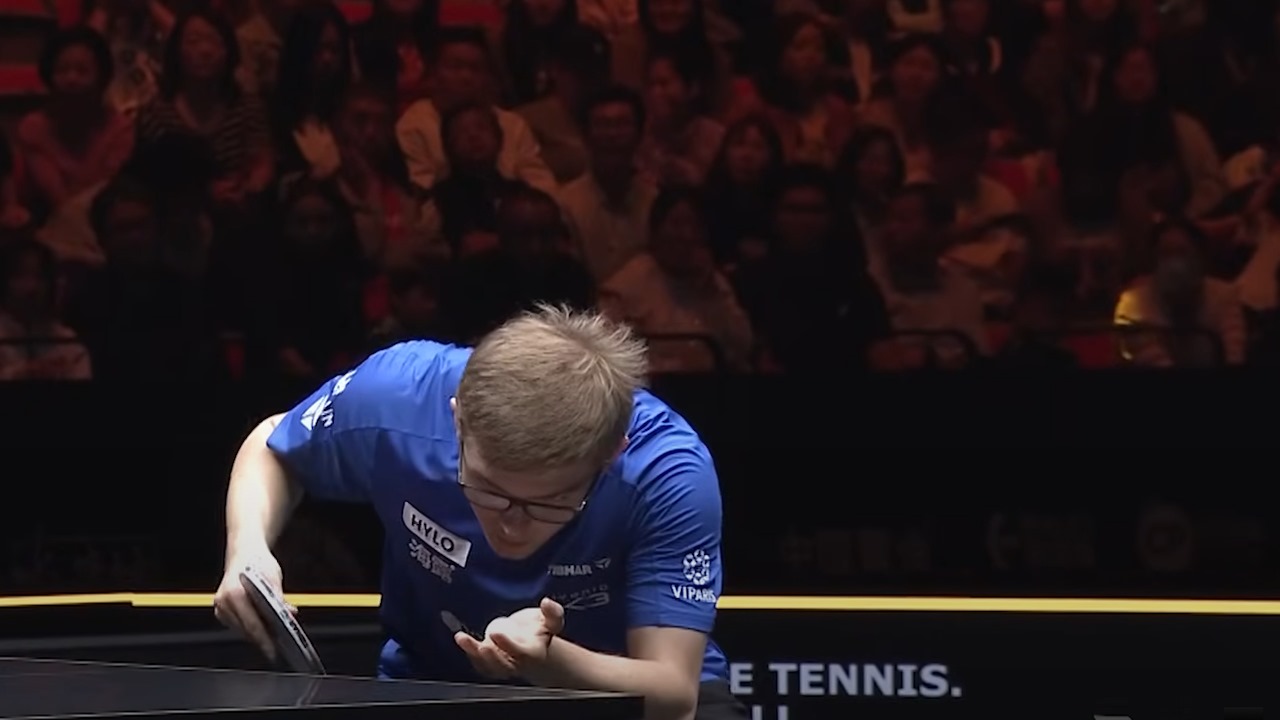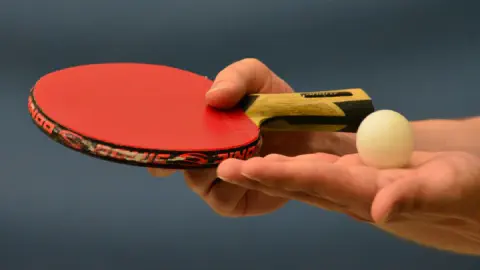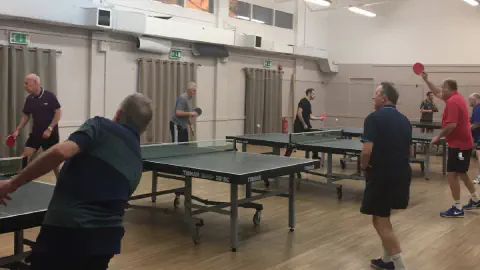Alexis Lebrun: France's Technical Maestro Charting His Own Path in the Shadow of Stardom
By: Simon
May 31, 2025 | Updated: October 22, 2025
Credit: ©World Table Tennis
Alexis Lebrun has carved out his position among the world’s top players at #9, demonstrating remarkable technical precision and tactical versatility that complement his younger brother Félix’s more explosive style. While navigating the unique challenge of competing alongside a sibling who has captured greater public attention, Alexis has established his own credentials through consistent performances at major tournaments, including a strong showing at the 2025 World Table Tennis Championships in Doha. His greatest triumph comes in doubles, where he and Félix form the world’s #1 ranked partnership, reaching the semifinals of the 2025 World Championships as top seeds. Alexis’s influence on his brother’s development, particularly in technical fundamentals and tactical discipline, has been crucial in their parallel journeys to the elite level of world table tennis.
Personal Background
Alexis Lebrun, born April 3, 2003, in Montpellier, France, grew up in a family where table tennis was central to daily life. The eldest son of Stéphane Lebrun, a former French national team member, Alexis was introduced to the sport at an exceptionally young age, with a racket placed in his hands almost as soon as he could walk. This early immersion established the foundation for what would become a lifelong dedication to table tennis.
Growing up in Montpellier, Alexis practiced primarily at the local club under his father’s guidance, developing a technically sound approach that reflected traditional European methodologies. Unlike many young players who specialize early, Alexis maintained a balanced educational path alongside his sporting development, completing his secondary education while training at increasingly intensive levels.
His transition to elite training occurred when he joined the French national training center at INSEP in his mid-teens, where his technical foundation was refined and his tactical understanding expanded. This environment proved crucial in his development, exposing him to diverse playing styles and professional training methodologies that accelerated his progression.
What distinguishes Alexis’s background is the unique dynamic of developing alongside his younger brother Félix, who eventually emerged as one of the sport’s most promising talents. Rather than creating rivalry, this relationship fostered mutual development, with Alexis serving as both mentor and training partner to Félix during crucial formative years. Their father Stéphane created an environment where both brothers could develop their individual styles while benefiting from constant high-quality practice together.
This supportive family structure has remained central to Alexis’s identity as a player, with the brothers continuing to train together extensively even as they compete at the highest levels of international competition. Alexis’s calm, methodical personality contrasts with Félix’s more extroverted nature, creating a complementary dynamic that has proven beneficial to both brothers’ development in the pressure-filled environment of elite table tennis.

Physical Attributes & Playing Style
Alexis Lebrun stands approximately 5'10" (178cm) with an athletic build that supports his technically demanding style of play. As a right-handed shakehand player, he represents a more classical European approach compared to his brother’s hybrid style. His physique allows for excellent balance and stability, particularly evident in his consistent technique during extended rallies and pressure situations.
Alexis’s playing style is characterized by technical precision and tactical intelligence rather than overwhelming power or spectacular athleticism. He operates primarily from mid-distance, excelling in controlled counter-attacking sequences where his exceptional timing and ball placement create advantages against even the most aggressive opponents. His backswing is compact but effective, generating sufficient power through perfect timing rather than extreme motion.
The cornerstone of Alexis’s game is his exceptional consistency. Where many players at his level might attempt high-risk shots to force outcomes, Lebrun demonstrates remarkable patience, maintaining precise ball placement and spin variation to gradually wear down opponents. This controlled approach has become his signature, allowing him to compete effectively against physically stronger or more athletically gifted opponents.
His forehand technique features excellent rotation and follow-through, generating heavy topspin with consistent depth that pressures opponents without unnecessary risk. His backhand, while less spectacular than his brother Félix’s, demonstrates similar technical precision with excellent blocking and counter-driving capabilities. The combination creates a balanced offensive threat from both wings without obvious weaknesses for opponents to exploit.
Alexis excels particularly in extended rallies, where his superior technique remains consistent even as pressure and fatigue build. His footwork is economical rather than explosive, emphasizing proper positioning and weight transfer over raw speed. This efficiency allows him to maintain high-quality stroke production throughout lengthy matches.
In doubles play, where he partners with Félix as the world’s top-ranked pair, Alexis typically handles more of the controlling aspects, providing consistency and tactical structure that complements his brother’s more dynamic style. This well-balanced partnership allows Alexis to showcase his exceptional anticipation and tactical awareness while Félix delivers the more spectacular attacking elements, creating a formidable combination that has challenged even the dominant Asian pairs.
Technical Analysis
Alexis Lebrun’s technical execution represents some of the most fundamentally sound stroke production in modern European table tennis. His forehand drive features a compact backswing with excellent hip rotation and weight transfer, generating considerable spin while maintaining precise control. The consistency of his contact point—slightly in front of his body with a brushing upward motion—allows him to produce nearly identical stroke mechanics regardless of the incoming ball’s speed or spin, a technical achievement that separates elite players from lower tiers.
His backhand technique demonstrates similar precision, with excellent wrist flexibility that enables varied degrees of topspin without telegraphing his intentions. While less aggressive than his brother’s backhand, Alexis’s execution features superior control and placement, particularly evident in crosscourt exchanges where he can manipulate angles with subtle adjustments to racket position and contact point.
Lebrun’s service technique reflects his overall approach to the game—technically precise with an emphasis on variation rather than pure deception. He employs a diverse repertoire of serves, including short backspin, sidespin variations, and occasionally long topspin serves, all delivered with nearly identical motion to disguise his intentions. His service strategy typically aims to control the subsequent rally rather than win points directly, setting up favorable patterns that play to his strengths.
In receive situations, Alexis demonstrates exceptional technique against both short and long services. His touch on short pushes allows him to keep the ball extremely low, neutralizing opponents’ third-ball attack opportunities, while his flick against half-long serves features excellent wrist snap that generates surprising power from minimal backswing. Against long services, his early timing and compact technique allow him to neutralize even the heaviest spin.
His movement technique prioritizes efficiency over speed, with small adjustment steps and excellent weight distribution that keep him balanced during transitions. This technical approach to footwork ensures he rarely appears rushed or out of position, maintaining stroke quality even during high-pressure sequences. His pivoting technique from backhand to forehand position is particularly refined, allowing smooth transitions without compromising his ready position.
What distinguishes Lebrun’s technical profile is his exceptional adaptability—he can seamlessly adjust his technique based on match situations without fundamental changes to his stroke mechanics. This technical flexibility allows him to maintain consistency across different playing conditions and opponent styles, a significant advantage in tournament settings where adaptability is crucial.
In doubles play with brother Félix, Alexis’s technical precision complements his brother’s more dynamic style, particularly in serve-receive situations where their coordinated techniques create significant advantages early in rallies. Their technical compatibility, developed through countless hours of practice together, makes their partnership particularly effective despite their contrasting individual styles.
Tactical Approach
Alexis Lebrun’s tactical intelligence represents perhaps his greatest strength as a player, demonstrating a chess-master’s approach to match play that compensates for any physical limitations against more athletic opponents. His fundamental tactical philosophy centers on controlled aggression—maintaining initiative without unnecessary risk-taking. This measured approach reflects his understanding that at the elite level, patience often trumps aggression, particularly against opponents expecting to dictate play.
Against aggressive attackers, Lebrun excels at neutralizing initial power through precise blocking and controlled counter-drives, gradually shifting momentum by returning balls with increasingly awkward placement and spin. This defensive-to-offensive transition represents a tactical signature that has proven effective against even the most powerful players, forcing them to generate increasing power as rallies extend, typically leading to eventual errors.
When facing defensive specialists, Alexis demonstrates exceptional patience, systematically varying placement, spin, and pace to disrupt their rhythm while avoiding the common mistake of over-forcing attacks. His tactical approach against choppers typically involves gradual buildup, starting with controlled topspins before increasing power only at strategically optimal moments when the defender’s position is compromised.
Lebrun’s serve and receive tactics reflect similar strategic depth. His service patterns typically follow carefully designed sequences, with initial serves setting up predictable returns that he can exploit with prepared third-ball attacks. In receive situations, he frequently employs tactical variety—sometimes aggressively attacking, other times playing controlled returns to disrupt the server’s rhythm and prepared patterns.
In tournament settings, Alexis demonstrates sophisticated energy management and tactical adaptation across matches. He can effectively adjust his tactical approach based on specific opponents, playing conditions, and his own physical state, a critical skill for maintaining consistent performance throughout lengthy competitions. This adaptability was evident during the 2025 World Championships in Doha, where he progressed through multiple rounds with different tactical approaches tailored to each opponent.
When partnering with Félix in doubles, Alexis typically assumes more of the tactical leadership role, subtly directing their strategic approach through serve selection and positioning choices. Their complementary understanding allows for seamless tactical adjustments during matches, with minimal verbal communication required due to their longstanding familiarity with each other’s tendencies.
Perhaps most impressively, Lebrun demonstrates exceptional tactical discipline in pressure situations, maintaining his strategic approach rather than resorting to desperate or low-percentage plays. This mental fortitude separates him from many similarly skilled players who abandon tactical plans under pressure, contributing significantly to his success at the highest levels of competition.
Equipment Details
Alexis Lebrun has maintained a consistent equipment setup throughout his senior career, reflecting his preference for familiarity and fine-tuned control over constant experimentation. As a sponsored Stiga athlete, he utilizes equipment from their professional range, carefully selected to complement his technical and tactical approach to the game.
For his blade, Lebrun employs the Stiga Carbonado 245, a seven-ply wood blade with two layers of carbon providing an excellent balance between speed and control. This blade choice reflects his playing philosophy—offering sufficient speed for offensive play while maintaining the feeling and precision necessary for his controlled counter-attacking style. The medium-hard outer plies provide excellent feedback during contact, supporting his emphasis on ball placement and spin variation.
Lebrun uses Stiga DNA Pro M rubber on his forehand, slightly softer than his brother Félix’s choice of DNA Pro H. This medium-hard composition provides excellent spin sensitivity and control while maintaining sufficient speed for offensive sequences. On his backhand, he employs the same DNA Pro M, creating a consistent feeling across both wings that enhances his balanced playing style. Both rubbers are used in maximum thickness (approximately 2.1mm) to optimize spin potential.
His equipment setup has remained remarkably stable throughout his career progression, with only minor adjustments to rubber hardness as his playing style has evolved. This consistency reflects his methodical approach to development, focusing on mastering equipment rather than seeking performance gains through frequent changes. The stability in his equipment choices has contributed to his technical consistency, allowing refinement of technique without introducing variables from changing equipment properties.
The overall character of Lebrun’s equipment can be described as balanced and versatile, avoiding extreme properties in favor of adaptability across different playing conditions and opponent styles. This approach aligns with his tactical flexibility, providing a reliable platform for his technical execution regardless of external factors.
In doubles competition with brother Félix, their equipment choices create an interesting complementarity—Alexis’s slightly softer setup providing enhanced control and spin sensitivity, while Félix’s marginally faster equipment supports his more dynamic attacking style. This subtle difference contributes to their effectiveness as a partnership, allowing each brother to fulfill distinct tactical roles within their doubles system.
Lebrun’s equipment choices ultimately reflect his identity as a player—technically precise, tactically versatile, and focused on consistency rather than spectacular but unreliable performance. His setup provides the tools necessary for his measured approach to competition without introducing unnecessary complexity or volatility to his game.
Career Achievements
Alexis Lebrun has compiled an impressive list of achievements throughout his career, establishing himself as one of France’s premier table tennis talents alongside his brother Félix. His current world ranking of #9 (as of May 27, 2025) represents the culmination of steady progression through the senior ranks, demonstrating consistent performance across multiple seasons and competitions.
His singles breakthrough came at the 2021 European Championships, where he reached the quarterfinals as a relatively unknown 18-year-old, announcing his potential on the continental stage. This was followed by progressive improvements on the WTT circuit, collecting victories over multiple top-20 players and securing his first WTT Contender title in 2023, defeating several established stars in the process.
At the 2025 World Table Tennis Championships in Doha, Alexis demonstrated his continued development, advancing through the early rounds with convincing performances. Despite an unfortunate withdrawal against Lin Yen-Chun in the Round of 64 due to injury concerns, his tournament performance reinforced his standing among the world’s elite players and his capacity to compete at the highest level.
Alexis’s most significant achievements have come in doubles competition partnering with his brother Félix. The Lebrun brothers currently hold the world #1 ranking in men’s doubles, a testament to their exceptional compatibility and complementary skills. Their doubles accomplishments include multiple WTT titles and a semifinal appearance at the 2025 World Championships in Doha as the tournament’s top seeds, where they defeated strong pairs including Sweden’s Falck/Karlsson before falling to Taiwan’s Kao/Lin partnership in a hard-fought semifinal.
As a key member of the French national team, Alexis has contributed to France’s resurgence in team competitions. At the 2024 Paris Olympics, he played a crucial supporting role as France challenged for team medals on home soil, providing vital points in their campaign. His steady performances in team events have established him as a reliable contributor in the sport’s highest-pressure environments.
While his individual accolades may be somewhat overshadowed by his younger brother’s meteoric rise, Alexis has established himself as an essential component of France’s table tennis resurgence. His steady progression through the rankings and consistent performance in major competitions demonstrate the value of methodical development and technical refinement, providing an alternative path to success compared to his brother’s more spectacular trajectory.
Alexis’s career achievements reflect his identity as a player—consistent, technically sound, and capable of competing with the world’s best through superior tactical intelligence rather than overwhelming physical attributes. His continued presence in the world’s top 20 represents significant achievement in an era dominated by Asian powerhouses, establishing him as one of Europe’s premier talents.
FULL MATCH | Alexis Lebrun vs Hugo Calderano | MS R64 | #ChinaSmash 2024 [Video]
Training Methodology
Alexis Lebrun’s training methodology reflects a carefully structured approach that has evolved throughout his development as a player. As part of the French national training system based at INSEP, his regimen combines traditional European technical emphasis with modern physical and psychological preparation tailored to his specific playing style and physical attributes.
His daily training typically begins with fundamental technical work, often including multi-ball sessions focused on refining stroke consistency and precision. Unlike players who prioritize spectacular shots, Alexis dedicates significant training time to perfecting basic techniques, recognizing that at elite levels, consistency in fundamental execution often determines outcomes. This technical foundation work typically occupies 1-2 hours each morning, with specific attention to service techniques, receive variations, and transitional movements between strokes.
Afternoon sessions generally focus on tactical implementation through match-play against varied sparring partners. The French national team environment provides access to diverse playing styles, allowing Alexis to test his tactical approaches against different challenges. Video analysis features prominently in this tactical development, with regular review sessions examining both his performances and potential opponents’ tendencies. This analytical approach aligns with his cerebral playing style, providing the tactical intelligence that defines his competitive identity.
Physical preparation constitutes a carefully calibrated component of his training regimen. Rather than pursuing maximum strength or explosiveness, Alexis’s physical work emphasizes endurance, core stability, and the specific movement patterns required for his tactical approach. This targeted conditioning supports his capacity to maintain technical precision throughout lengthy matches and tournaments, a crucial factor in his consistent performance.
What distinguishes Alexis’s training methodology is the unique component of his partnership with brother Félix. The brothers maintain regular joint training sessions, creating a specialized practice environment that benefits both players. For Alexis, these sessions provide consistent exposure to Félix’s explosive left-handed style, while allowing him to refine the controlled counter-attacking techniques that form the foundation of his game. Their doubles training, integrated throughout the week, has proven particularly valuable, developing the coordinated movement and tactical understanding that has propelled them to the world #1 doubles ranking.
Mental preparation represents an increasingly important aspect of Alexis’s development program. Working with sports psychologists, he has developed techniques for maintaining focus during high-pressure situations and managing the unique psychological challenges of competing alongside his more publicly celebrated younger brother. This mental resilience was evident during the 2025 World Championships, where he demonstrated remarkable composure despite the spotlight frequently focusing on Félix.
Alexis’s training methodology ultimately reflects his identity as a player—methodical, detail-oriented, and focused on consistent improvement rather than spectacular but unsustainable performance spikes. His approach demonstrates that in modern table tennis, intelligent, structured training can compete effectively with the volume-based systems prevalent in Asian powerhouses.
Influence & Legacy
Despite being just 23 years old, Alexis Lebrun has already established a meaningful influence on French and European table tennis that extends beyond his competitive achievements. His most significant impact comes through his role in what has become known as the “Lebrun Revolution” in French table tennis—the rise of both brothers that has revitalized the nation’s standing in the sport and inspired a new generation of young players.
Alexis’s influence on his younger brother Félix’s development represents perhaps his most important contribution to table tennis history. As Félix’s primary training partner and tactical mentor during formative years, Alexis provided the competitive framework and technical foundation that accelerated Félix’s meteoric rise. This mentorship role continues today, with Alexis frequently offering tactical insights and emotional support that help Félix navigate the pressures of elite competition. Their relationship demonstrates how sibling cooperation rather than rivalry can produce extraordinary athletic development.
For French table tennis specifically, Alexis represents a crucial link between generations. His technically sound, tactically intelligent approach embodies traditional European playing virtues while incorporating modern elements necessary to compete with Asian powerhouses. This blend of classical technique with contemporary tactics provides an accessible model for developing French players, demonstrating that European methodologies remain viable at the highest levels when properly executed and adapted.
In doubles competition, the Lebrun brothers’ achievement of the world #1 ranking has significant implications for European table tennis. Their success challenges the historical dominance of Asian partnerships in doubles, providing a tactical and technical template for European pairs to follow. Their complementary playing styles—Alexis’s controlled consistency balanced with Félix’s dynamic attacking—illustrates how differing individual approaches can create formidable partnerships when properly coordinated.
Within the French national team structure, Alexis has emerged as a stabilizing presence, providing reliable performance in team competitions while supporting younger players’ development. This leadership role, often exercised quietly behind the scenes, has contributed significantly to France’s resurgence as a table tennis power, culminating in their strong showing at the home Olympics in 2024.
Perhaps most importantly, Alexis’s career trajectory offers an alternative path to success compared to his brother’s more spectacular rise. Where Félix captured attention through precocious achievement against established stars, Alexis has demonstrated the value of methodical progression, technical refinement, and tactical intelligence. This parallel success story provides important perspective for developing players, illustrating that different developmental paths can lead to elite achievement.
While Alexis’s ultimate legacy remains to be written as his career continues, he has already established himself as an essential figure in France’s table tennis resurgence and an influential model for technically-oriented European players seeking to compete in an increasingly dynamic, athletic sport.
Current Standing & Context Among Peers
Alexis Lebrun’s current world ranking of #9 (as of May 27, 2025) places him firmly among the global elite, particularly impressive considering the continued dominance of Asian players in the top rankings. Within European table tennis, this position establishes him among the continent’s premier talents, part of a small group of European players consistently challenging for titles on the WTT circuit. He is a long-time rival of Truls Möregårdh.
In the context of French table tennis, Alexis stands as the nation’s second-highest ranked player behind his brother Félix (#7), creating a formidable one-two punch that has propelled France back into the sport’s elite nations. This dual presence in the world’s top 20 represents a significant achievement for French table tennis, providing depth that translates to team strength in international competitions.
Alexis’s standing among his peers is defined not just by his ranking but by the respect his technical quality and tactical intelligence command from fellow professionals. Unlike players who rely primarily on physical attributes or spectacular techniques, Lebrun has established his reputation through consistent performance against varied opponents, demonstrating adaptability that many specialists lack. This versatility makes him a particularly challenging opponent in tournament settings where adaptability proves crucial across multiple matches.
In doubles competition, Alexis and Félix currently hold the world #1 ranking, reflecting their exceptional compatibility and balanced skill sets. Their semifinal appearance at the 2025 World Championships confirmed this status, demonstrating their capacity to challenge even the strongest Asian partnerships in the sport’s most prestigious events. This doubles prowess adds another dimension to Alexis’s standing, establishing him as one of the world’s most complete players across singles and doubles disciplines.
The recent 2025 World Table Tennis Championships in Doha provided context for Alexis’s current standing. Despite his unfortunate withdrawal against Lin Yen-Chun in the Round of 64, his earlier performances demonstrated his continued development and capacity to compete at the highest level. In doubles, the Lebrun brothers’ advance to the semifinals as top seeds confirmed their status as the world’s premier partnership, even though they ultimately fell to Taiwan’s Kao/Lin pair in a hard-fought contest.
Within his generation of players (those born between 2000-2005), Alexis has established himself among the most accomplished, part of a cohort that includes Sweden’s Truls Moregard, Japan’s Tomokazu Harimoto, and China’s Wang Chuqin. While perhaps not receiving the same media attention as some of these peers, his steady progression and balanced skill set place him firmly in this elite group that will likely define the sport’s next decade.
Like a precisely placed counter-drive that lands exactly where intended, Alexis Lebrun’s career has followed a carefully plotted trajectory to reach the sport’s highest echelons. While operating somewhat in the shadow of his brother’s more spectacular rise, Alexis has established his own distinctive place among the world’s elite through technical excellence, tactical intelligence, and an unwavering commitment to consistent improvement.
Follow Alexis Lebrun on Social Media
Alexis Lebrun vs Wang Chuqin | MS R16 | #WTTChongqing 2025 [Video]
Featured Articles
Dive into in-depth stories, exclusive interviews, and expert advice from the world of table tennis. Discover strategies, player spotlights, and behind-the-scenes insights.

Ping Pong Revolution: How Table Tennis Transforms Homes, Offices, and Communities
Table tennis is uniquely positioned as one of the most versatile recreational activities available today. This comprehensive article explores the transformative impact of ping pong across three …

Basic Equipment Needed to Play Table Tennis
What is the basic equipment that you need to get started with playing ping pong? Our guide to the very basic table tennis equipment required to go ahead and start to play. A guide to the basics of …

Is Ping Pong Good Exercise? The Top Health Benefits Explained
Table tennis is great exercise both for mind and body. You can use ping pong to keep fit alongside other exercise programs and raise your overall activity levels to lose weight and keep your mind …

Ping Pong Revolution: How Table Tennis Transforms Homes, Offices, and Communities
Table tennis is uniquely positioned as one of the most versatile recreational activities …

Basic Equipment Needed to Play Table Tennis
What is the basic equipment that you need to get started with playing ping pong? Our guide …

Is Ping Pong Good Exercise? The Top Health Benefits Explained
Table tennis is great exercise both for mind and body. You can use ping pong to keep fit …

